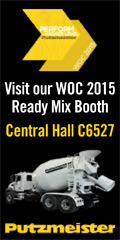
| Archive | nrmca.org | E-Store | Conferences & Events | Certifications | InFocus | Membership Directory |
Federal Transportation Officials Issue New Guidance on 30-Minute Break Language Following the early August U.S. Court of Appeals for the District of Columbia Circuit ruling vacating the Hours of Service (HOS) 30-minute break for short-haulers, the Federal Motor Carrier Safety Administration (FMCSA) issued guidance on exactly to whom the 30-minute break rule did NOT apply. FMCSA’s guidance stated that commercial motor vehicle (CMV) drivers who are able to take advantage of the 100 air-mile logging exemption do not need to take the 30-minute break. This guidance applies to concrete mixer drivers, provided the drivers meet the exemption criteria, which in part, include not driving beyond 100 air-miles from the ready mixed concrete plant that a driver starts and stops at each day, and that the driver is released from duty by, at most, 12 hours after first coming on duty.
While this was great news for the industry, it also inadvertently created a compliance gray area. Specifically, a very real and common scenario includes a driver who starts the work day intending on utilizing the 100 air-mile logging exemption, but due to unforeseen and uncontrollable issues, has to work beyond that 12-hour threshold. This scenario immediately puts that driver out of compliance with both the 30-minute break and also entire 100 air-mile logging exemption. While there is guidance on how to rectify this issue to be compliant outside of the 100 air-mile logging exemption, there is not any guidance on the 30-minute break compliance.
NRMCA back in August and again in November, met with FMCSA officials to highlight this inconsistency. In response, FMCSA has issued guidance on how to treat such instances. Specifically, FMCSA states:
"To address this issue, FMCSA advises that in such situations, the driver should not be considered to be in violation of the break rule. The driver should annotate the RODS [Record of Duty Status] to indicate why the required rest break was not taken earlier, and should take the break at the earliest safe opportunity. Ideally, this would be prior to preparing the RODS or immediately following the preparation of the RODS. Under FMCSA’s existing HOS requirements and guidance, drivers would begin preparing the RODS as soon as they determine they are no longer eligible for the RODS exemption."
While NRMCA had suggested alternative guidance better suited to short-haul operations, NRMCA is pleased with FMCSA’s acknowledgement of the issue and the necessity for issuing guidance. We now have guidance that lets us decide when it is "safe" to take a 30-minute break when working more than 12 hours. In some cases it will probably be pretty easy for a driver to retroactively log and then find some time during the day when he/she took a 30-minute break while other drivers can finish delivering loads, return to the plant and still be in compliance.
Finally, despite the overall success on pushing back the required 30-minute break for short-haulers, NRMCA’s HOS work is not finished. In early November, NRMCA met with FMCSA to further discuss the industry’s 30-minute break exemption request. At the November meeting, NRMCA agreed to submit to FMCSA more information on the industry and how safety will not be compromised. Following the submittal of this information, FMCSA scheduled an internal meeting to discuss the industry exemption request and indicated it would make a decision early in 2014.
Click here to view the full Federal Register notice. For more information, contact NRMCA's Gary Mullings at gmullings@nrmca.org or Kevin Walgenbach at kwalgenbach@nrmca.org.
|
|
|







